
Diarsia dahlii, the barred chestnut, is a moth of the family Noctuidae. The species was first described by Jacob Hübner in 1813. It is found in Europe, through the Palearctic east to the Kamchatka Peninsula, northern China and Japan.

Aseptis fumosa is a moth of the family Noctuidae first described by Augustus Radcliffe Grote in 1879. It is widespread in western North America and is known from western Canada, Washington, Nebraska, Colorado, Utah, Arizona, Nevada and California. It occurs in a variety of diverse habitats including coast chaparral, dry conifer forest, and shrub steppe.
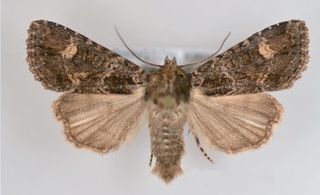
Aseptis binotata, the rusty shoulder knot moth, is a moth of the family Noctuidae. The species was first described by Francis Walker in 1865. It is found widespread in western North America, west of south-central Alberta, Wyoming, and Nebraska. Along the Pacific Coast it occurs from northern Mexico to south-central British Columbia. It can be found from sea level to altitudes over 2000 meters in a variety of habitats from dense forest to shrub desert.

Paraseptis is a monotypic moth genus in the family Noctuidae erected by Tomas Mustelin and Lars G. Crabo in 2015. Its only species, Paraseptis adnixa, was first described by Augustus Radcliffe Grote in 1880. It is widely distributed along the Pacific Coast from northern Mexico to south-western British Columbia in a variety of forested habitats.
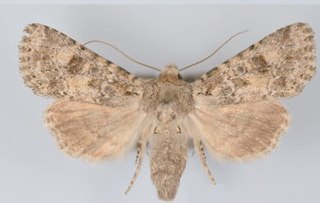
Aseptis catalina is a moth of the family Noctuidae first described by John Bernhardt Smith in 1899. It is found in the deserts of Arizona, California and Baja California in Mexico.

Aseptis characta is a moth of the family Noctuidae first described by Augustus Radcliffe Grote in 1880. It is widespread in western North America, where it is found in the western Great Plains, Great Basin, and Pacific regions from British Columbia, Alberta, and Saskatchewan to Colorado, Utah, northern Arizona and southern California. The species occurs in dry habitats like sagebrush steppe, juniper woodlands, and open forest from sea level to 2,500 meters.

Aseptis fumeola is a moth of the family Noctuidae first described by George Hampson in 1908. It is found in the US state of Arizona, southern and central California, southern Nevada and south-eastern Utah. The habitat consists of foothills and mountains in dry chaparral, parkland, and conifer forest.

Drasteria parallela is a moth in the family Erebidae. It is found in the Cascade Mountains of Washington, the Klamath and Siskiyou Mountains of south-western Oregon and the northern Sierra Nevada in California. The habitat consists of exposed ridges in forests at middle elevations.

Ichneutica scutata is a moth of the family Noctuidae. It is endemic to New Zealand. This species can be found in the southern parts of the North Island as well as the eastern parts of the South Island. It is similar in appearance to I. insignis and I. skelloni but can be distinguished as I. scutata is much paler in appearance. It is likely this species inhabits lowland tussock grasslands as well as coastal dunes although it is not common in inland tussock grasslands. The larvae feed on a variety of herbaceous plants such as Plantago and Convolvulus species, Plagianthus divaricatus. It pupates on soil near its host plants. The adults are on the wing from late March to July.

Aseptis murina is a moth of the family Noctuidae first described by Tomas Mustelin in 2000. It is found in the US in southern California, where it occurs in coastal chaparral, foothills, mountain brush land and oak forest, and in the mountain-desert transition zone from sea level to 2000 meters.

Aseptis ferruginea is a moth of the family Noctuidae first described by Tomas Mustelin in 2000. It is endemic to southern California. All records are from San Diego County, from an area between Boulevard-Manzanita near the Mexican border north to Lake Henshaw at altitudes of 800–1600 meters. The habitat consist of open oak forest, foothill chaparral, and in the mountain-desert transition zone.

Aseptis fanatica is a moth of the family Noctuidae first described by Tomas Mustelin in 2006. It is found in western North America in Washington, Oregon, California, and Baja California Norte in Mexico. It is found in habitats like brush land and open forest in southern California, mostly at 1000–2000 meters, but occurs at lower elevations farther north.

Aseptis lichena is a moth of the family Noctuidae first described by William Barnes and James Halliday McDunnough in 1912. It is found in the United States in south-central California and north-central California. It is also reported from Mount Shasta, Mount Lassen, and other locations in northern California.
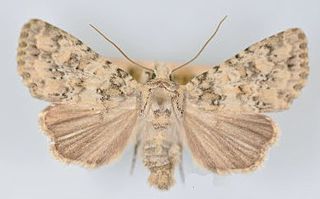
Aseptis pseudolichena is a moth of the family Noctuidae first described by Tomas Mustelin and Ronald Henley Leuschner in 2000. It is endemic to southern California, with records from San Diego, Riverside, Los Angeles, Ventura, San Bernardino, and Tuolumne counties. The habitat consists of open pine and oak forest, open areas with grass and scrub, and foothill chaparral.

Aseptis serrula is a moth of the family Noctuidae first described by William Barnes and James Halliday McDunnough in 1918. It is found in the lower mountain-desert transition zone and in high desert such as the Mojave, Colorado, and Sonora deserts of south-eastern California, Nevada, Arizona and Baja California.
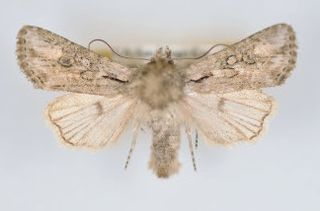
Aseptis torreyana is a moth of the family Noctuidae first described by Tomas Mustelin in 2006. It is found in along the south side of the sea level salt marsh estuary of Torrey Pines State Natural Reserve in Southern California. The habitat is most likely salt marsh, although it could be coastal chaparral.
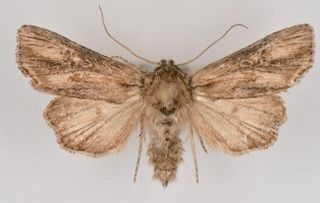
Aseptis susquesa is a moth of the family Noctuidae first described by John Bernhardt Smith in 1908. It is found in Arizona, California and Baja California in Mexico, at least as far south as Ensenada. The habitat consists of rocky areas in the mountain-desert transition zone and high desert.
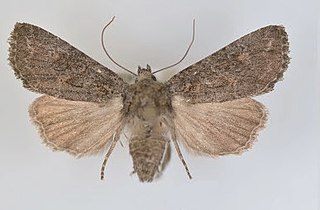
Aseptis perfumosa is a moth of the family Noctuidae first described by George Hampson in 1918. It is endemic to southern California, where it occurs in many habitats such as coastal chaparral and canyons, urban areas, brush land, and open oak forest from sea level to 2000 meters.
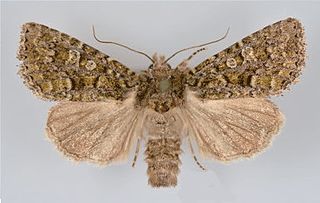
Viridiseptis is a monotypic moth genus in the family Noctuidae erected by Tomas Mustelin and Lars G. Crabo in 2015. Its only species, Viridiseptis marina, was first described by Augustus Radcliffe Grote in 1874. It is found throughout coastal California and in south-western Oregon as far north as Douglas County. It is widely distributed in southern California. It is found in many habitats such as coastal chaparral, mountain forest, mountain-desert transition zone, and occasionally in the deserts from sea level to at least 2000 meters.

Ichneutica paracausta is a moth of the family Noctuidae. This species is endemic to New Zealand. It is found locally in the central North Island, is widespread in the South Island and can also be found in Stewart Island. I. paracausta is variable in colour, but as it has a distinctive black streak on its forewing as well as a wing pattern that is characteristic, I. paracausta is unlikely to be confused with other species. It is present on the North Island volcanic plateau as well as Little Bush Reserve in Hawkes Bay in the North Island as well as in tussock grassland, alpine and subalpine shrubland and in alpine forest. Larvae have been recorded as feeding on grasses, a pupa has been found in a cocoon under the bark of a tree and adult moths are on the wing from October to January.





















